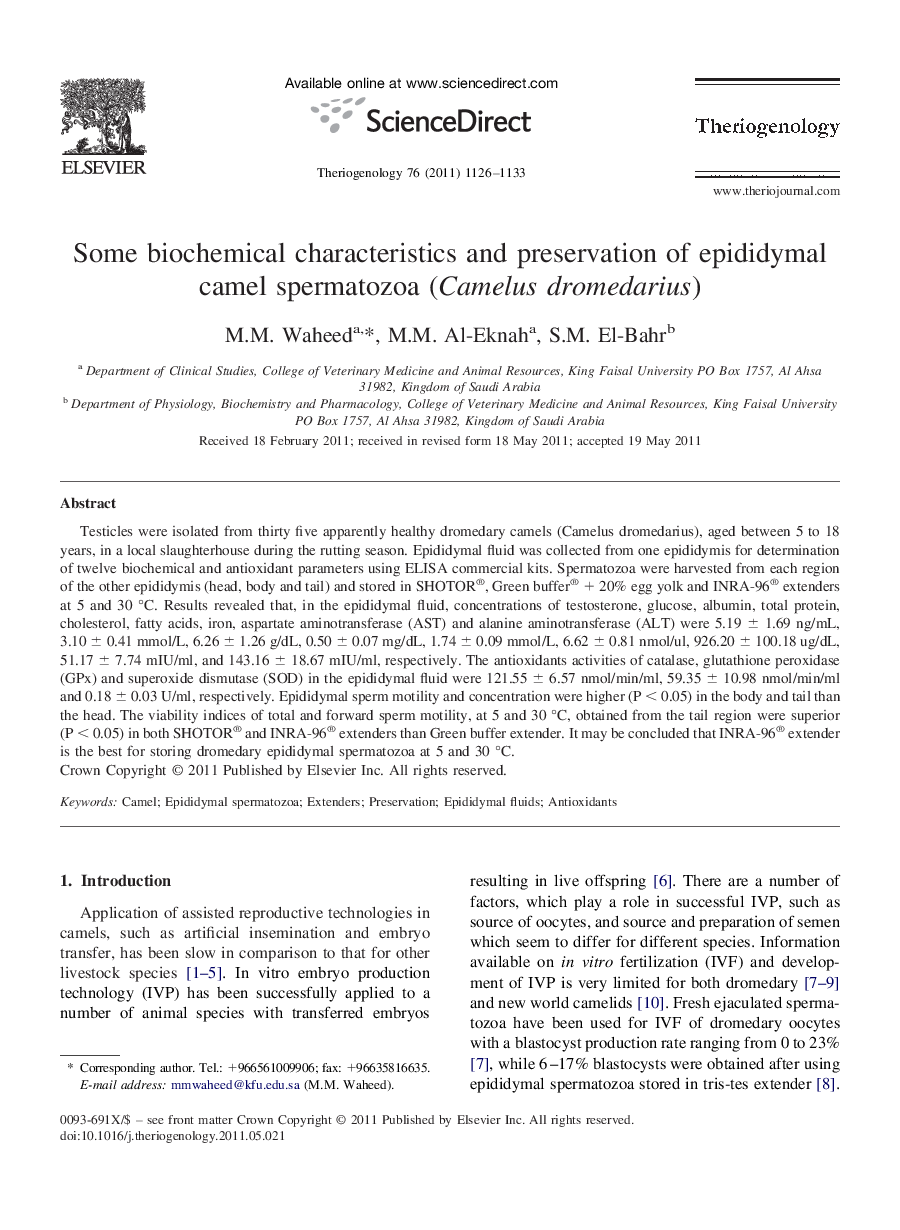| کد مقاله | کد نشریه | سال انتشار | مقاله انگلیسی | نسخه تمام متن |
|---|---|---|---|---|
| 10892608 | 1082110 | 2011 | 8 صفحه PDF | دانلود رایگان |
عنوان انگلیسی مقاله ISI
Some biochemical characteristics and preservation of epididymal camel spermatozoa (Camelus dromedarius)
دانلود مقاله + سفارش ترجمه
دانلود مقاله ISI انگلیسی
رایگان برای ایرانیان
کلمات کلیدی
موضوعات مرتبط
علوم زیستی و بیوفناوری
علوم کشاورزی و بیولوژیک
علوم دامی و جانورشناسی
پیش نمایش صفحه اول مقاله

چکیده انگلیسی
Testicles were isolated from thirty five apparently healthy dromedary camels (Camelus dromedarius), aged between 5 to 18 years, in a local slaughterhouse during the rutting season. Epididymal fluid was collected from one epididymis for determination of twelve biochemical and antioxidant parameters using ELISA commercial kits. Spermatozoa were harvested from each region of the other epididymis (head, body and tail) and stored in SHOTOR®, Green buffer® + 20% egg yolk and INRA-96® extenders at 5 and 30 °C. Results revealed that, in the epididymal fluid, concentrations of testosterone, glucose, albumin, total protein, cholesterol, fatty acids, iron, aspartate aminotransferase (AST) and alanine aminotransferase (ALT) were 5.19 ± 1.69 ng/mL, 3.10 ± 0.41 mmol/L, 6.26 ± 1.26 g/dL, 0.50 ± 0.07 mg/dL, 1.74 ± 0.09 mmol/L, 6.62 ± 0.81 nmol/ul, 926.20 ± 100.18 ug/dL, 51.17 ± 7.74 mIU/ml, and 143.16 ± 18.67 mIU/ml, respectively. The antioxidants activities of catalase, glutathione peroxidase (GPx) and superoxide dismutase (SOD) in the epididymal fluid were 121.55 ± 6.57 nmol/min/ml, 59.35 ± 10.98 nmol/min/ml and 0.18 ± 0.03 U/ml, respectively. Epididymal sperm motility and concentration were higher (P < 0.05) in the body and tail than the head. The viability indices of total and forward sperm motility, at 5 and 30 °C, obtained from the tail region were superior (P < 0.05) in both SHOTOR® and INRA-96® extenders than Green buffer extender. It may be concluded that INRA-96® extender is the best for storing dromedary epididymal spermatozoa at 5 and 30 °C.
ناشر
Database: Elsevier - ScienceDirect (ساینس دایرکت)
Journal: Theriogenology - Volume 76, Issue 6, 1 October 2011, Pages 1126-1133
Journal: Theriogenology - Volume 76, Issue 6, 1 October 2011, Pages 1126-1133
نویسندگان
M.M. Waheed, M.M. Al-Eknah, S.M. El-Bahr,